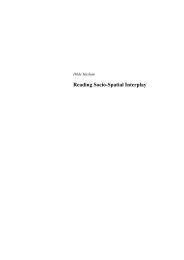A Laboratory Ideas
A Laboratory Ideas
A Laboratory Ideas
Create successful ePaper yourself
Turn your PDF publications into a flip-book with our unique Google optimized e-Paper software.
this burgeoning international ava nt-garde community,<br />
including such varied prac titioners as<br />
Joseph Beuys, H enning Christiansen, Robert<br />
Filliou, Bengt af Klintberg, Willem de Ridder,<br />
and Ben Vautier. Others joined later, including<br />
Jeff Berner, Geoffrey H endricks, Milan Kniza k,<br />
and me. 5<br />
It is important to note that Flux us was a<br />
community rather than a collective with a common<br />
artistic and political program. 6 (None of<br />
the artists signed the suppo ed Flux us manifestoes<br />
that George M aciunas created- not even<br />
George himsel f. ) Several streams of thought meet<br />
in th e work and prac tices of the Fluxus community.<br />
One stream is the well-known Fluxus<br />
relationship to the teaching of John Cage, and<br />
to related lines of practice reaching back to Z en<br />
Buddhism. 7 Another stream is the more oblique<br />
but still strong relationship to ea rlier- twentiethcentury<br />
ava nt-garde manifestations ranging from<br />
LEF and constructivism to Dada (though Fluxus<br />
people were not linked to the anarchistic and<br />
des tructive ethos ofDada).<br />
Perhaps the best short definition of Fluxus<br />
is an elegant little manifesto that Dick Higgins<br />
published in 1966 as a rubber stamp:<br />
Flux us is not:<br />
-a moment in history or<br />
-an art movement.<br />
Flux us is:<br />
-a way of doing things,<br />
- a tradition, and<br />
-a way oflife and death.B<br />
These words summarize the time-bound,<br />
transformational, and interactive development<br />
of Flu x us. In the late 1970s, I suggested using<br />
content analysis of Flux us projects to give an<br />
overview of Fluxus, and in 1981, Peter Frank<br />
and I used this method to chart the participants<br />
for a history of Fluxus 9 In 1991, James Lewes<br />
brought our chart forward in time by surveying<br />
twenty-one Flux us exhibitions, catalogues, and<br />
books. The resulting chart offers an overview of<br />
the "who was who (and where)" ofFluxus over a<br />
thirty-year period. 10<br />
The study suggested a consensus of opinion<br />
about the allegiance of those whose names<br />
appea red in more than half of th e compilations<br />
as a key participant in Fluxus. There were thirtythree<br />
artists on this list: Eric Andersen, Ay-0 ,<br />
Joseph Beuys, George Brecht, Philip Corner, Jea n<br />
Dupuy, Robert Filliou, Albert Fine, Ken Friedman,<br />
Al H ansen, Geoffrey H endricks, Dick Higgins,<br />
Joe Jones, Milan Kniza k, Alison Knowles,<br />
Addi K0pcke, Takehisa Kosugi, Shigeko Kubota,<br />
George M aciunas, Larry Miller, Yoko Ono,<br />
N am June Paik, Benjamin Patterson, Takaka<br />
Saito, Tomas Schmit, Mieko Shiomi, Daniel<br />
Spoerri, Ben Vautier, Wolf Vostell , Yoshimasa<br />
Wada, Robert Watts, Emmett Williams, and La<br />
Monte Young. These thirty-three individuals are<br />
included in the majority of projects and exhibitions,<br />
but a broad vision of the Flu x us community<br />
would include m any more, among others<br />
Don Boyd, Giuseppe Chiari, Esther Ferrer, Juan<br />
Hidalgo, D av i det Hampson, Alice Hutchin ,<br />
Bengt af Klintberg, Carla Liss, Jackson M ac<br />
Low, Walter Marchetti, Richard M axfield, Jonas<br />
M ekas, Carolee Schneem ann, Greg Sharits, and<br />
Paul Sharits.<br />
In 1982, Dick Higgins wrote an essay in<br />
w hich he attempted to id e11 tify nine criteria<br />
th at di stinguished, or indicated the qualities of,<br />
Fluxus: internationalism, experimentalism and<br />
iconoclasm , intermedia, minimalism or concentration,<br />
an attempted resolution of the art/<br />
life dichotomy, implicativeness, play or gags,<br />
ephemerality, and specificity. Later on I worked<br />
with Dick's list, expanding it to twelve criteria:<br />
globalism, the unity of art and life, intermedi a,<br />
experimentalism , chance, playfulness, simplicity,<br />
implicativeness, exemplativism , specificity,<br />
presence in time, and musicality. 11 While Flu xus<br />
had neither an explicit re ea rch program nor a<br />
common conceptual program, a range of reasonable<br />
issues could be labeled id eas, points of<br />
commonality, or conceptual criteriaY If they do<br />
36 Fluxus .1nd the E~semi.1l Qut'\tJom nfLJtt•

















